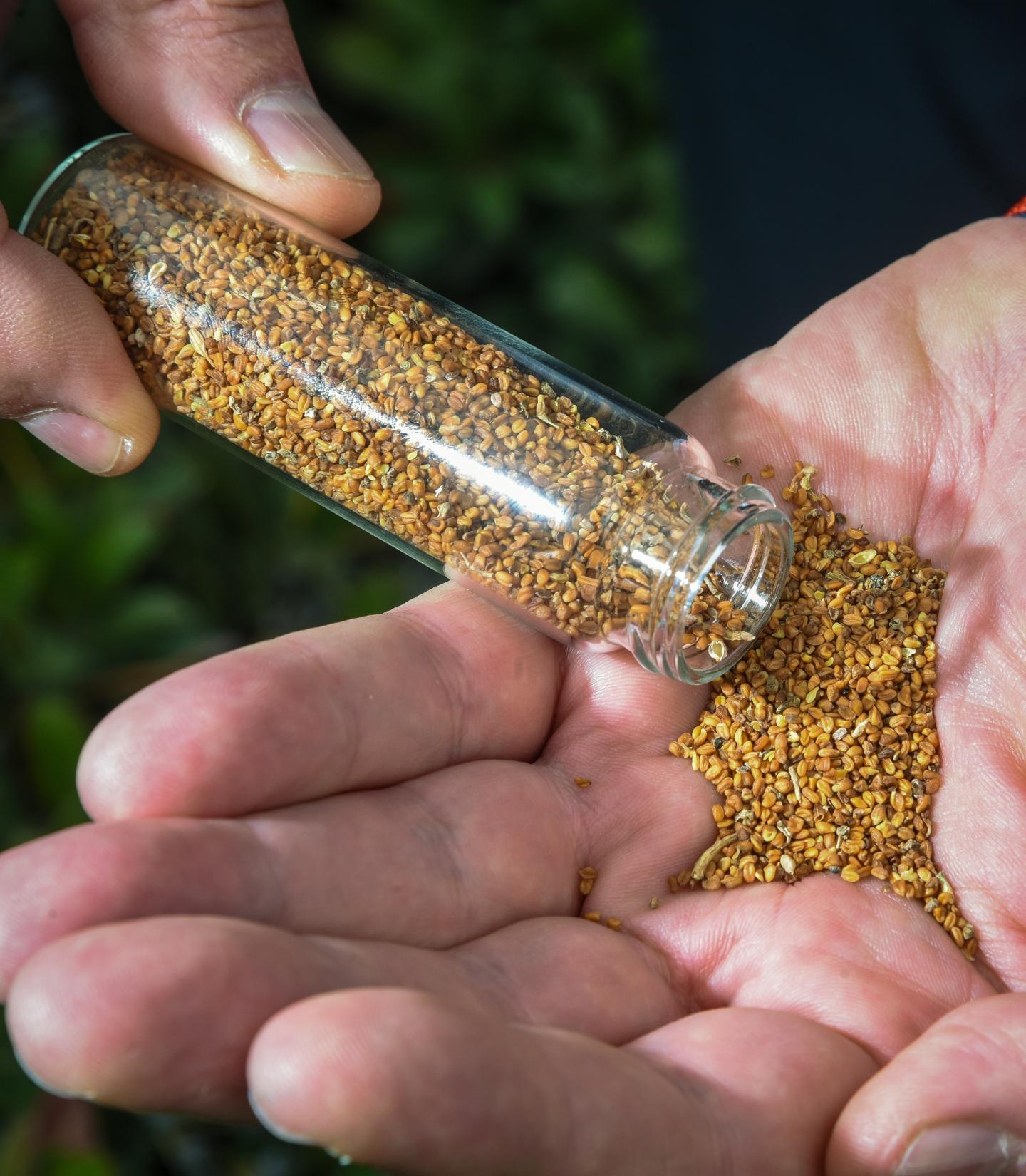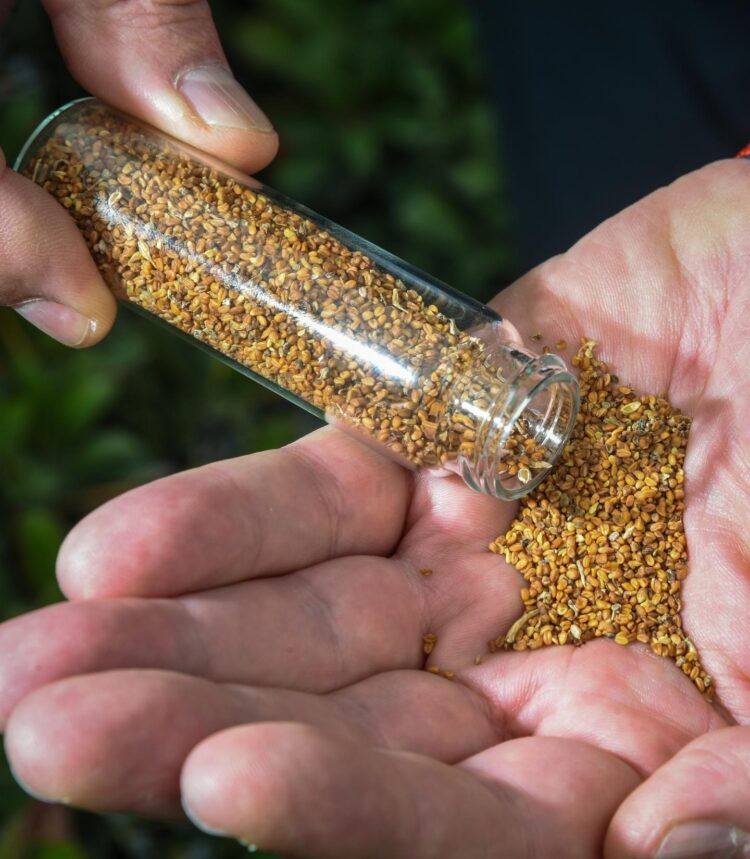GM plant to give boost to green insect controls

Credit: Kurt Miller Photography
RIVERSIDE, Calif. — The camelina plant, a source of cooking oil for centuries, is on its way toward revolutionizing pest control in agriculture.
Scientists at ISCA, Inc., a green agtech company based in Riverside, Calif., and their collaborators in Sweden have successfully “grown” insect sex pheromone precursors in genetically modified strains of camelina plants, creating a low-cost source of pheromones needed for sustainable pest control.
The Swedish research team from the Lund University, Swedish Agricultural University, and SemioPlant, modified the genetic code of these plants to contain genes of insects and other organisms that guide the formation of the desired pheromones. The plants produce insect pheromone precursor compounds in their abundant seed oil.
ISCA, a world leader in pheromone-based insect controls, has grown successive generations of the transgenic camelina plants and developed a prototype product with plant-derived pheromones to control the cotton bollworm moth (Helicoverpa armigera), a major world pest species that causes hundreds of millions of dollars annually in damage to cotton, corn, tomato, chickpea, and other crops.
Results from an initial trial in Brazil showed that the ISCA formulation with plant-derived pheromones performed just as well as a formulation with pheromones made from standard chemical synthesis techniques. Both suppressed H. armigera populations in bean fields by preventing adult moths from mating. ISCA is also developing plant-derived pheromones controls for the fall armyworm, Spodoptera frugiperda, another devastating moth species.
The camelina plant innovation recently received a substantial financial investment from the U.S. Department of Agriculture (USDA) for further development and commercialization. The $650,000 grant from the USDA’s National Institute of Food and Agriculture (NIFA) followed an earlier $100,000 grant for an initial phase of the project, called “Grow Your Own Pheromone.” NIFA awarded the grants through its Small Business Research Innovation program. The grant to ISCA will support ongoing efforts to develop transgenic camelina strains that produce the sex pheromones of other moth pest species and corresponding sustainable pest control products.
“We are very excited with NIFA/USDA’s investment in our company,” said ISCA’s CEO Agenor Mafra-Neto. “Pheromone and other semiochemical controls are the future of crop protection, and ISCA’s breakthrough biological pheromone synthesis will propel agriculture into a more lucrative and sustainable enterprise. Efficacious pheromone controls are badly needed, especially now that global agriculture faces increasing pest resistance that renders conventional insecticides less effective and increasing pressure from governments and consumers demanding ever safer and greener food production.”
In Sweden, the transgenic plants were developed under the five-year Oil Crops for the Future research program funded by the Swedish Foundation for Strategic Research.
“We are very happy to see that collaboration with ISCA will bring this innovation to the market for the benefit of environmentally friendly pest control,” said research leader and Lund University Biology Professor Christer Lofstedt. “In collaboration with ISCA, we hope to develop new lines to target several other important pests.”
Pheromones are among the next generation of insect controls because they protect crops by manipulating the behavior of problem insects, such as by preventing them from mating or by repelling them away from crops. Unlike conventional insecticides, pheromone controls affect only the targeted pest species – leaving bees and other wildlife unharmed. Additionally, pheromones do not leave harmful residues on food produce, cause little or no environmental pollution, and are far less prone to pest resistance.
The costs of synthesizing pheromones, however, have limited their application. By having plants do most of the synthesis work, pheromone production costs will be slashed. Biosynthesis in plants also eliminates the need to use petroleum-based chemicals as feedstock and bypasses most of the complex organic chemistry steps that are now required in pheromone manufacturing.
The camelina plant (Camelina sativa) is a cousin of broccoli and canola that has been cultivated as an annual crop for centuries as a source of healthy cooking oil. Putting the plant to work to create low-cost sources of insect pheromones is expected to give a big boost to earth-friendly mating disruption controls for several devastating moth species. In nature, the female moths release into the air a species-specific sex pheromone to call males for mating. Applications of the same pheromone in the field, however, create thousands of pheromone trails that lead to nowhere. This makes it nearly impossible for the males to find mates. The females are left to lay sterile eggs, which prevents the next generation of highly damaging caterpillars from hatching, protecting the crops.
For more information or to set up an interview, please contact ISCA USA Communications Director David Danelski at (951) 850-0143 or [email protected].
###
About ISCA:
ISCA, Inc. is a green agtech company that provides the next generation of insect control products for world agriculture by harnessing the power of pheromones and other semiochemicals that manipulate the behavior of targeted insect species. ISCA’s insect control innovations are environmentally sustainable, cost-effective, and can be applied mechanically to both row and specialty crops. ISCA is headquartered in Riverside, California, and has offices and manufacturing facilities in the United States, Brazil, and India.
Media Contact
David Danelski
[email protected]
Original Source
https:/





